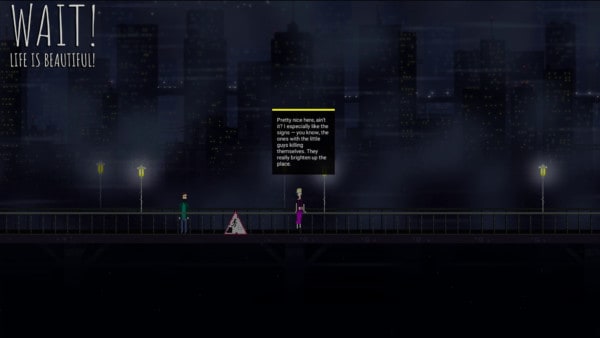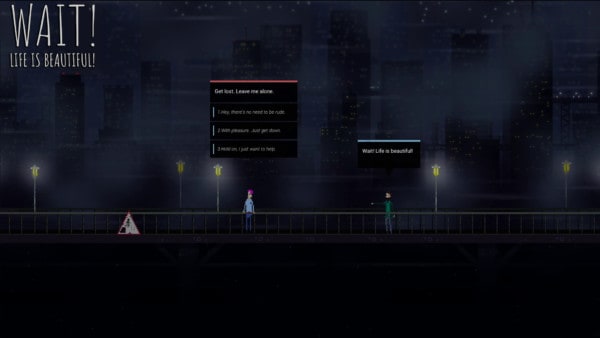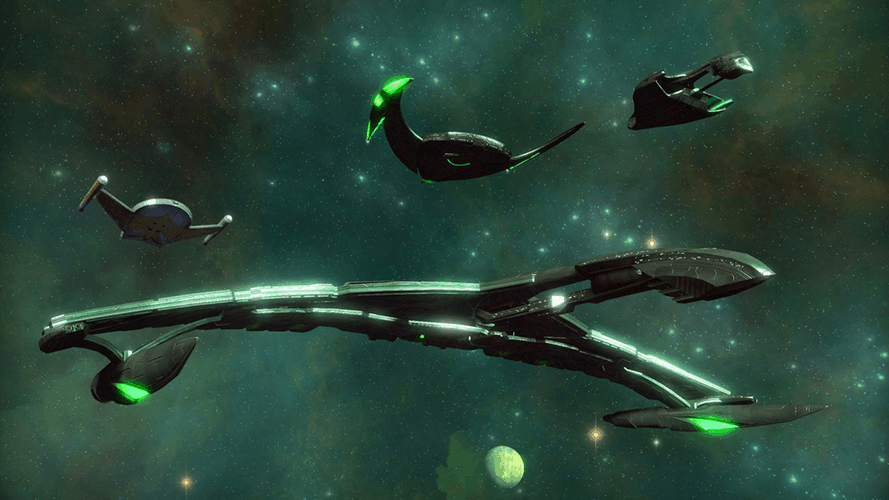You never know what you’ll come across when you’re browsing the trending section on Steam. That’s particularly true if you’re hanging out in the “free to play” part like I usually am. There are games for virtually every mood here, from playful Battle Royale titles like King of Crabs to creepy East Asian horror games, like Ginkgo.
The game that most caught my eye this week was a slightly more macabre creation. Wait! Life is Beautiful! is a game where you spend your time trying to talk people out of jumping to their deaths on a bridge that’s seen its fair share of sadness.
According to the developer [DRAMATIC MUSIC PLAYS], the game was something of a therapeutic exercise. The developer started creating this game during a rough patch in their life. They wanted to show the world how common suicide is, and how terrible it can feel when you’re lost in a place with seemingly no way out.

Today, I’m going to talk you through the game Wait! Life is Beautiful!
However, if you have any negative feelings as you read through this piece or know anyone suffering with suicidal thoughts, please, don’t hesitate to get help.
The Challenge of Staying Positive
Finding a purpose in life is something that many of us struggle with. We connect ourselves to other people and fill our lives with hobbies to keep us entertained, but many people don’t know what it is they’re supposed to do. It’s that kind of thing that can leave many of us feeling lost.
Wait! Life is Beautiful! is a title that reminds people to pay attention to the world and people around them. The protagonist in the game sits waiting on Suicide Bridge in the hope that they can prevent victims from throwing their lives away.
Obviously, this game is intended to be engaging, so it’s not all doom and gloom. However, there is a disclaimer at the start reminding you to get help if you have any suicidal thoughts. I’m going to add my own disclaimer to that and say, expect this game to leave you feeling a little bleak.
Your character is an average person, bored with life, and looking for an answer. The action of the game revolves around regular dialogue with people who are clearly down on their luck.

Obviously, the concept of mental health issues, sadness, and even suicide are some pretty huge themes to cover. I can see some people enjoying the challenge and depth of these games, while others just find it upsetting.
Your role in this game is to start a negotiation with every person you meet with the line, “Wait! Life is Beautiful”. The people you meet will respond, telling you their problems, or arguing why they don’t want to be around. It’s up to you to say the right thing to convince whoever you speak to that life is worth another shot.
The people you speak to aren’t exactly the best listeners. The developer has put some of their own experiences with depression and other issues into the characters. Some people simply don’t want to be saved, and they’re so quick to jump that there’s basically nothing you can do.
So, why bother?
An Interesting Approach to a Difficult Topic
Wait! Life is Beautiful! isn’t a game that you play to rack up achievements and points. It’s a statement on society and people in general. This complicated experience wants to open your eyes to the reality of the people suffering around you.
If the developers can fix a few basic issues, like the slightly glitchy graphics and poor-quality writing in places, you’ve got a really impressive visual novel. The nostalgic graphics reminded me a lot of Party Hard, which is a very different kind of game.

The actual gameplay is interesting. The developer has a lot of points to make in this title. The complexity of the dialogue choices shows how difficult it can be to say the right thing to talk someone off the ledge. The diversity of the characters, and the problems they face show us how almost anything can push someone to do something drastic.
If you ask me, I think the developer could have taken a slightly gentler approach with the learning curve. Most people jump after a single sentence, and you can’t go back and retry anything. If you’re just figuring out how to play for the first time, you might lose so many NPCs that you can’t see the point of going back in.
The dramatic music in the background is a nice touch and an insight into the thoughts and feelings of the developer. Despite very simple graphics, it’s clear that the company doesn’t want to undermine mental health issues or suicidal thoughts here.
There’s something about this game that’s compelling, but it’s definitely not a fun experience. Every time the screen turns to static as someone hurls themselves over the ledge, you feel a sinking sensation in your chest. Even though some of the people you encounter aren’t easy to resonate with, it’s hard to stop your brain from churning.
So, why aren’t I just throwing this game in the “do not recommend” pile?
Because like any good piece of art, it makes you think.

A Game for Self-Reflection
Without a doubt, there will be some people who get triggered by this game. It’s dark, painful, and incredibly introspective. Just because the art style is simple and pixelated, it doesn’t mean that the themes of the game aren’t exceptionally deep.
It takes a while before you can actually get to the point of saving people. However, with every line of dialogue you deliver, you sense the true weight of your words. The screen rumbles and the music deepens as you talk. The developer wants us all to see just how meaningful our words can be.
I found it hard to come up with a solid verdict on this game – because it didn’t feel like a game at all. It’s an intense experience where you tap buttons on a keyboard. However, more than anything, Wait! Life is beautiful! seems like a plea from the developer. It’s a request for all of us to slow down and consider the impact that we have on the people around us.
Personally, I’m intrigued to see what this company might do next.




























You must be logged in to post a comment Login